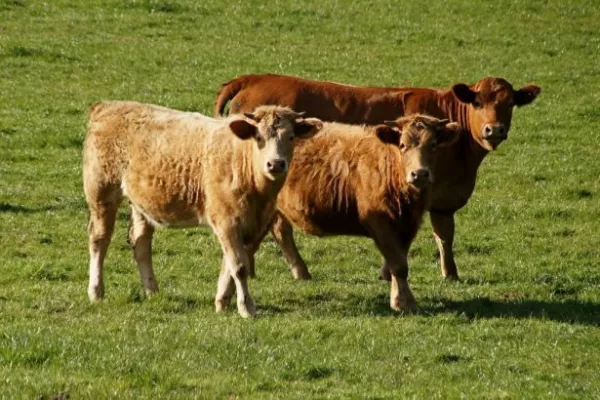Everything at Blue Hill at Stone Barns in Pocantico Hills, N.Y., has a story. Servers, chefs, and farmers at the restaurant, which was recently ranked No. 11 in the world, are there to tell it to anyone with a few hundred dollars, several hours, and a reservation.
Depending on the day’s menu, the braised pork belly may come from red wattle pigs, prized by Chef Dan Barber for their high fat content. At one point during a recent meal, a diner's candle was extinguished and poured over plates as a sauce, because—surprise: The candle was made of beef tallow. It's likely the only fine dining establishment where a trip to the manure shed is as coveted as dessert. All are part and parcel of the Blue Hill at Stone Barns experience.
Farm-to-table restaurants usually skip over just one small detail during these dramatic narratives. It's arguably the most important step in the process, but few people want to think about slaughter when they're cutting into their dinner.
It's also often cited as the most difficult. Despite ever-increasing customer demand for noncommodity meat, there aren't enough slaughterhouses to keep up. It's a major hitch in the supply chain—keeping supplies down, prices up, and making the already grueling job of farming even harder.
Phil Haynes is the assistant livestock manager at the Stone Barns Center for Food and Agriculture, the open-to-the-public farm and education hub that supplies many of Blue Hill's ingredients. On a freezing March morning, he awoke before sunrise and drove four red wattles about an hour and 15 minutes to Dealaman Enterprises, Inc. in Warren, N.J. With the help of a Dealaman staffer, Haynes led the animals into a dark barn filled with the rank odor of fresh manure, before heading back to work. He'd make the same journey the next day, only then he’d return to Stone Barns with the carcasses.
Between Haynes's trips, the animals met their fate in a small room so clean and brightly lit that a single smear of guts on the white wall seems out of place, though neat piles of them sit on the floor. In a process that takes about 30 minutes per pig, the animal is stunned, slaughtered, scalded, and eviscerated. Various innards are sorted appropriately—livers on a spike, lungs in a garbage pail.
Even at Blue Hill, which exemplifies the aspirational closed-loop, farm-to-table meal, slaughter of pigs and sheep requires a trip off premises. Under USDA regulations, farm staff must take these animals to a federally inspected facility to serve it at the restaurant or sell it at the Stone Barns store, though an exemption for small amounts of poultry staying in the state allows them to slaughter their chickens, turkeys, and ducks in an on-site, state-certified facility.
Stone Barns is more fortunate than many other farms, said Jack Algiere, the Center's farm director. The slaughterhouse is "very close, considering," he says. Others are forced to "drive two, three, four hours for processing."
While the situation varies from species to species and state to state, sellers of noncommodity pork, beef, and chicken agree: there simply aren't enough facilities to humanely and safely kill their animals.
The numbers are stark. In 1967 there were 9,627 livestock (cattle, calf, hog and sheep) slaughtering establishments in the U.S. That same year, Congress passed the Wholesome Meat Act, requiring producers to use a USDA-inspected facility if they sell meat across state lines. A mass consolidation of the meat industry followed. Today, commodity meat is dominated by large companies. Just four companies sell about 85% of America's beef and the pork and chicken markets are similarly controlled by huge corporations. By 2016, there were only about 1,100 federally inspected meat and poultry slaughterhouses in the country.
But customers are increasingly demanding free-range meat from smaller producers that, largely because of the lack of slaughterhouse, aren't able to supply it fast or cheap enough. Volume sales for free-range meat, for example, was up 26.9 percent in 2016, while conventional was down 0.5 percent, according to data from Nielsen Fresh.
Just a handful of large slaughterhouses handle a disproportionate amount of that American meat: Of those approximately 1,100 facilities, 215 large slaughter establishments (defined as 500 or more employees) produce about 75 percent to 90 percent of the country's volume. At the Smithfield plant in Tar Heel, N.C., for example, approximately 30,000 to 34,000 hogs are reportedly slaughtered each day. At the other end of the spectrum is Dealaman, the only federally inspected hog slaughterhouse in New Jersey, which processes a paltry 1,200 pigs a week.
The explanations for the struggles of the small slaughterhouses vary but inevitably come down to two interrelated factors—regulations that favor large meatpackers and uneven enforcement of those regulations.
The federal rules for packing houses are, understandably, complex, and adherence can be expensive. But they are essentially the same whether a facility is slaughtering 100 head each day or 10,000. Many argue that laws created to help inspectors monitor large facilities are ill-suited to small ones. "There is no question in my mind that you can have a safe, operating small custom house without having the same regulations that you have for a large packer," said J. Dudley Butler, the former head of the USDA's Grain Inspection, Packers and Stockyards Administration, who actively worked to diversify the meat industry during his tenure. "That's a terrible regulatory burden on small packing houses."
The USDA’s Food Safety and Inspection Service offers a small plant help desk and help with regulations and trainings, but smaller operators still complain about not being in the know, because they don't have the resources. "We simply don't have the capacity to send a guy to every trade seminar to learn how to game the system," says Joel Salatin of Polyface Farm in Virginia's Shenandoah Valley and co-owner of the processing plant T&E Meats.
Smaller slaughterhouse operators commonly make claims of disparate treatment and even intimidation by inspectors. Large establishments rack up violations as well—their noncompliance rate is actually a bit higher than that of their smaller counterparts. But smaller facilities see a disproportionate amount of enforcement. In April 2017, seven enforcement actions were issued, according to an FSIS spokesperson—and five went to small and very small plants. In other words, slaughterhouses that produce a maximum of 25 percent of the country's beef, pork, and chicken received 71 percent of the month's enforcement actions.
The USDA says it's just doing its job. "USDA's FSIS makes no exceptions when it comes to the safety of our food supply and protecting the health of American families," a spokesperson said in a statement. "Our inspectors take appropriate regulatory actions to ensure that the nation's commercial supply of meat, poultry and egg products is safe and wholesome, regardless of the size of the establishment."
As consumers clamor for small-scale meat, producers are racing to provide it, but the lack of slaughterhouses hinders growth.
"This is my bottleneck in my company today," says Ariane Daguin, owner of high-end meat purveyor D'Artagnan. Daguin insists on approving not just the farms but also the slaughter facilities processing her meat, which she says can be a particular challenge. She works with a range of heritage breeds whose varied sizes and morphologies need more flexibility than a typical, highly mechanized assembly line setup can offer. When the Pennsylvania plant that had been processing her Amish-raised chickens went out of business, she had to reconfigure the whole supply chain, eventually substituting birds raised and slaughtered in the Midwest to fill the gap. "Today we are back with the same [Amish farmers]," she says. "But it took me two and a half years to find a replacement."
Scheduling is another challenge. Slaughterhouses often require six months notice. The independent, USDA slaughterhouses that are still in business are often booked solid, and cancellations for such things as illness or poor weather can be costly. It can take months to get a new appointment, forcing farmers to devote more time and resources to the animals in question, which cuts into their already slim margins. "What was a profit now becomes a loss," says Jon McConaughy, co-founder of Double Brook Farm in Hopewell, N.J., who built his own on-site slaughterhouse for approximately $350,000 after concluding it was the most economically feasible option.
Finding a local slaughterhouse is not just a matter of time and convenience. Small-scale farmers with heritage animals pride themselves on the higher animal welfare standards they say produce superior meat. After devoting months to carefully raising rare breeds on customized diets, farmers are loathe to end the animals' lives at facilities that may mistreat them. Farmers say they will travel longer distances for better facilities they trust more. The last slaughterhouse Stone Barns used, Haynes said, was mistreating the animals. "I'm not working with those guys anymore. They don't respect us, don't respect the animals."
It's not just a compassion issue—transportation of livestock is often cited as a major stressor for animals and associated with lower meat quality, and the last hours or minutes in an animal's life can undo months of effort.
Facilities that are better for animals are often likely to be better for workers, too. Unlike the large processing houses, where workers' repetitive motions often lead to carpal tunnel syndrome and other injuries, Dealaman's workers move around, trading positions and tasks, one minute gutting, the next sweeping, the next scalding. This is not uncommon in small operations, but it also adds to the price of meat.
Such a flexible workplace requires more higher-skilled laborers, so smaller operations often offer a higher hourly wage than large plants. "We take care of our folks, pay way above the minimum wage, in the $20-to-$22-per-hour range," said Salatin. That is significantly higher than the $13/hour average wage for a slaughterhouse worker in the US.
In 2015, Republican Thomas Massie of Kentucky and Democrat Chellie Pingree of Maine (both farmers) introduced the PRIME [Processing Revival and Intrastate Meat Exemption] Act in the House of Representatives. The bill would allow farmers to sell chops, steaks, and other cuts of beef and pork processed in state-regulated custom slaughterhouses as long as the sales stayed within state lines.
"My wife just drove three hours to pick up three steers," said Massie, who raises grass-fed crossbreeds of Angus and Wagyu cattle on his farm. "The frustrating thing is that she passed a processor three miles from our house that can do the exact same thing, but it's not a USDA facility. "
The bill faces stiff opposition from strange bedfellows: the Big Meat lobbyists at the North American Meat Institute and consumer group Food & Water Watch.
"Despite what these advocates want to believe, bacteria don’t distinguish between large and small facilities," says Eric Mittenthal of the North American Meat Institute. "To have the safest food system possible, the same food safety standards should be followed by everyone."
"We don't think the PRIME Act really deals with the safety concerns," says Tony Corbo, senior lobbyist for the food campaign at Food & Water Watch, largely because custom slaughterhouses must meet state regulations but do not have inspectors on site at all times.
Some say that's inadequate. "At the state levels, the quality of the kill, process, and safety, frankly, is not sufficient," Daguin says. "You do need regulations, but the regulations in force are the wrong ones."
Massie argues that these smaller scale, state-regulated custom slaughterhouses provide more traceability and less commingling of products from different sources, which ultimately makes them safer. Federal regulations, he said, "have failed to protect the public from mass recalls and very large outbreaks of food-borne illnesses."
Advocates also point to the recent scandal around Brazilian meat giant JBS SA. In March, Brazilian authorities announced an investigation into evidence that the company bribed government officials to allow the export of its tainted meat. While the USDA says no beef from the implicated facilities has reached the U.S., and FSIS has stepped up its inspections on imports from the country, PRIME Act advocates ask why Brazil has better access to US markets than many American ranchers do.
The PRIME Act doesn't require allowing sales of these meats; it simply gives states the authority to regulate such sales themselves. But Massie blames the industry for wanting to keep the status quo. "There aren't any big moneyed interests in Congress supporting this bill, and if you want to see what's happening in Congress, generally you should follow the money," Massie says. "When you dig into the opposition, a lot of times you'll find it's funded by one of the meatpackers."
Agribusiness spent more than $133 million on lobbying in 2015, but Mittenthal says "zero dollars and resources" were expended by NAMI on this issue.
Massie plans to reintroduce the bill in the next few months and hopes its bipartisan nature will help move it along. "Republicans like that we're reducing federal regulations, and the Democrats like that it will enable production and consumption of local food," he said.
For now, though, he and his wife will keep having to make the three-hour trek each way to the slaughterhouse. "That's not very environmentally friendly or efficient," he said.
News by Bloomberg, edited by Hospitality Ireland









